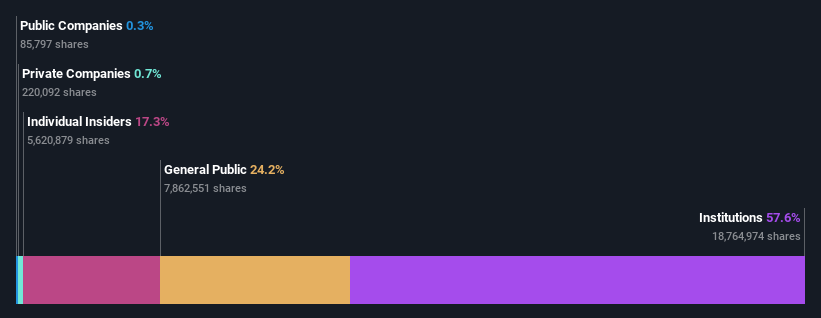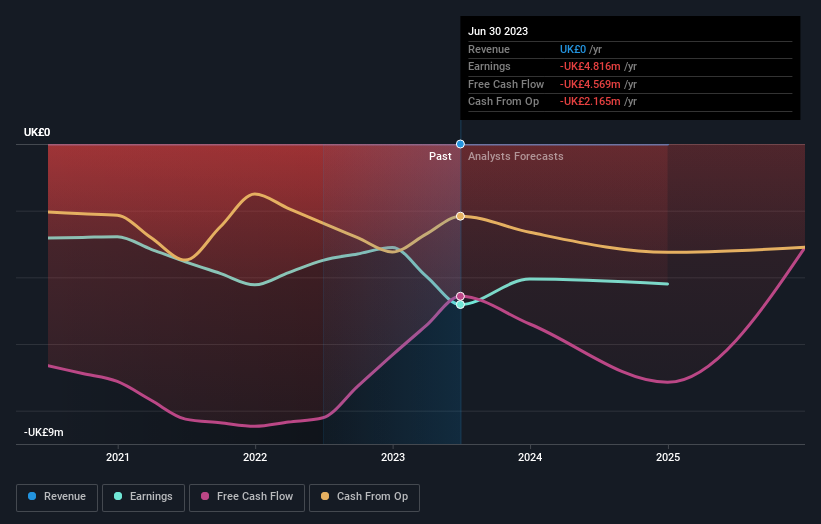Institutional investors control 58% of Jersey Oil and Gas Plc (LON:JOG) and were rewarded last week after stock increased 15%
Key Insights
Institutions' substantial holdings in Jersey Oil and Gas implies that they have significant influence over the company's share price
51% of the business is held by the top 12 shareholders
A look at the shareholders of Jersey Oil and Gas Plc (LON:JOG) can tell us which group is most powerful. With 58% stake, institutions possess the maximum shares in the company. That is, the group stands to benefit the most if the stock rises (or lose the most if there is a downturn).
And as as result, institutional investors reaped the most rewards after the company's stock price gained 15% last week. One-year return to shareholders is currently 13% and last week’s gain was the icing on the cake.
In the chart below, we zoom in on the different ownership groups of Jersey Oil and Gas.
Check out our latest analysis for Jersey Oil and Gas
What Does The Institutional Ownership Tell Us About Jersey Oil and Gas?
Institutional investors commonly compare their own returns to the returns of a commonly followed index. So they generally do consider buying larger companies that are included in the relevant benchmark index.
As you can see, institutional investors have a fair amount of stake in Jersey Oil and Gas. This can indicate that the company has a certain degree of credibility in the investment community. However, it is best to be wary of relying on the supposed validation that comes with institutional investors. They too, get it wrong sometimes. It is not uncommon to see a big share price drop if two large institutional investors try to sell out of a stock at the same time. So it is worth checking the past earnings trajectory of Jersey Oil and Gas, (below). Of course, keep in mind that there are other factors to consider, too.
Since institutional investors own more than half the issued stock, the board will likely have to pay attention to their preferences. Jersey Oil and Gas is not owned by hedge funds. James Baldwin is currently the largest shareholder, with 6.5% of shares outstanding. In comparison, the second and third largest shareholders hold about 5.4% and 5.0% of the stock. Furthermore, CEO J. Benitz is the owner of 2.2% of the company's shares.
A closer look at our ownership figures suggests that the top 12 shareholders have a combined ownership of 51% implying that no single shareholder has a majority.
Researching institutional ownership is a good way to gauge and filter a stock's expected performance. The same can be achieved by studying analyst sentiments. There is a little analyst coverage of the stock, but not much. So there is room for it to gain more coverage.
Insider Ownership Of Jersey Oil and Gas
The definition of an insider can differ slightly between different countries, but members of the board of directors always count. Company management run the business, but the CEO will answer to the board, even if he or she is a member of it.
Insider ownership is positive when it signals leadership are thinking like the true owners of the company. However, high insider ownership can also give immense power to a small group within the company. This can be negative in some circumstances.
Our information suggests that insiders maintain a significant holding in Jersey Oil and Gas Plc. Insiders own UK£14m worth of shares in the UK£81m company. This may suggest that the founders still own a lot of shares. You can click here to see if they have been buying or selling.
General Public Ownership
With a 24% ownership, the general public, mostly comprising of individual investors, have some degree of sway over Jersey Oil and Gas. While this size of ownership may not be enough to sway a policy decision in their favour, they can still make a collective impact on company policies.
Next Steps:
It's always worth thinking about the different groups who own shares in a company. But to understand Jersey Oil and Gas better, we need to consider many other factors. Case in point: We've spotted 4 warning signs for Jersey Oil and Gas you should be aware of, and 2 of them shouldn't be ignored.
But ultimately it is the future, not the past, that will determine how well the owners of this business will do. Therefore we think it advisable to take a look at this free report showing whether analysts are predicting a brighter future.
NB: Figures in this article are calculated using data from the last twelve months, which refer to the 12-month period ending on the last date of the month the financial statement is dated. This may not be consistent with full year annual report figures.
Have feedback on this article? Concerned about the content? Get in touch with us directly. Alternatively, email editorial-team (at) simplywallst.com.
This article by Simply Wall St is general in nature. We provide commentary based on historical data and analyst forecasts only using an unbiased methodology and our articles are not intended to be financial advice. It does not constitute a recommendation to buy or sell any stock, and does not take account of your objectives, or your financial situation. We aim to bring you long-term focused analysis driven by fundamental data. Note that our analysis may not factor in the latest price-sensitive company announcements or qualitative material. Simply Wall St has no position in any stocks mentioned.


